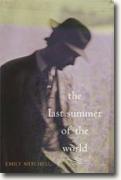The Last Summer of the World
Emily Mitchell
book reviews:
· general fiction
· chick lit/romance
· sci-fi/fantasy
· graphic novels
· nonfiction
· audio books
· author interviews
· children's books @
curledupkids.com
· DVD reviews @
curledupdvd.com
newsletter
win books
buy online
links
home
for authors
& publishers
for reviewers

 |
The Last Summer of the World Emily Mitchell W.W. Norton Hardcover 352 pages June 2007 |
|
One of the most exhilarating aspects of reading literary fiction is that it can illuminate
little-known facts about people, places and historical events. This is particularly the case with famed photographer Edward Steichen (1879 -1973), who comes to life from deep within the pages of Emily Mitchell's multi-layered and achingly exquisite first novel, The Last Summer of the World
Thus, in Mitchell's accomplished hands, this early period of Steichen's kaleidoscopic life gradually emerges as a tale of creative growth and emotional pain delivered in a series of moving accounts that move back and forth between the photographer's artistic beginnings in Milwaukee in 1898 to the bitter divorce from his wife Clara after he settles in France at the end of the Great War. We first meet Edward when he is working for the British Army in Northern France as one of the observers, working with the pilots to take pictures over the various sectors of the front lines. One morning, just as he is about to go out on a mission, Edward receives a letter from his friend Marion Beckett telling him that Clara has filed suit against her best friend in New York, accusing Marion of having had a liaison with him before the war. If indeed the suit does come to trial, Marion will need Edward's help to counter the accusations against her - and against him, too. The news throws Edward into a sense of self-righteous anger, and he reckons the easiest thing is to do nothing at all as Marion's letter does not request any specific action, except to help when the time comes and the case goes to trial. So begins Edward's odyssey as he tries to forge a balance between the struggles of past and the mysteries of the future. He also tries to reconcile his failed marriage to Clara with his deep feelings for Marion, while coping with the collateral impact of the War where his friends and colleagues are being slaughtered before his very eyes. In more contented times, Edward was a young and idealistic photographer who arrived in Paris, determined to ask his hero, the famed sculptor Auguste Rodin, if he could take his portrait; the picture would be part of a series of photographic portraits of great men of the time. It is here, at Rodin's home in Meudon, that Edward is greeted warmly by the older man and comes alive to Rodin's energies and to the creative process. Rodin tells Edward of the restrictions that he places upon himself by the conventional life, the bourgeois life: "The wonderful energy choked off by a concern for morality." But to his own detriment, Edward never loses his weakness for pretty, attractive women, and his liaisons with artist and sculptress Kathleen Bruce and the actress Isadora Duncan ultimately prove to be his undoing. Meanwhile, Mitchell contrasts Marion's dispassionate attitude toward life with Clara's emotional volatility. Certainly Edward loved Clara, and he had an overwhelming feeling of tenderness, of wanting to protect her from the world and from the worst parts of himself. But only with Marion can Edward elude, temporarily at least, the shadows that have fallen across their lives. Mitchell delves deep into Steichen's personality, his development as a photographer, and his steadily growing ideas about art and how the loveliest art is made by "free instinct." Of course, the real world is far messier and more confusing than photographs sometimes betray; it's where dreams are denied as fulfilled, where many loves fail to endure, and where war is inevitably brutal and blood-soaked. In the end, this absolutely superb and delicately affecting novel is about the sufferings of a handsome iconoclast and artistic innovator who proved it indeed possible for a photograph to represent more than just surfaces: a photographer could actually be an artist who makes a difference and who can ultimately tell the truth about war, love and passion. Originally published on Curled Up With A Good Book at www.curledup.com. © Michael Leonard, 2007 |
|
|
|
 Click here to learn more about this month's sponsor! |
|
| fiction · sf/f · comic books · nonfiction · audio newsletter · free book contest · buy books online review index · links · · authors & publishers reviewers |
|
| site by ELBO Computing Resources, Inc. | |
 Having established himself as a fine art painter in the beginning of the 20th century, Steichen assumed the pictorialist approach to photography. In World War I, he commanded the photographic division of the American Expeditionary Forces, which gave him the opportunity to become dangerously involved with aerial photography even as
he was deeply shocked by the death and carnage that he witnessed on the Western Front.
Having established himself as a fine art painter in the beginning of the 20th century, Steichen assumed the pictorialist approach to photography. In World War I, he commanded the photographic division of the American Expeditionary Forces, which gave him the opportunity to become dangerously involved with aerial photography even as
he was deeply shocked by the death and carnage that he witnessed on the Western Front.